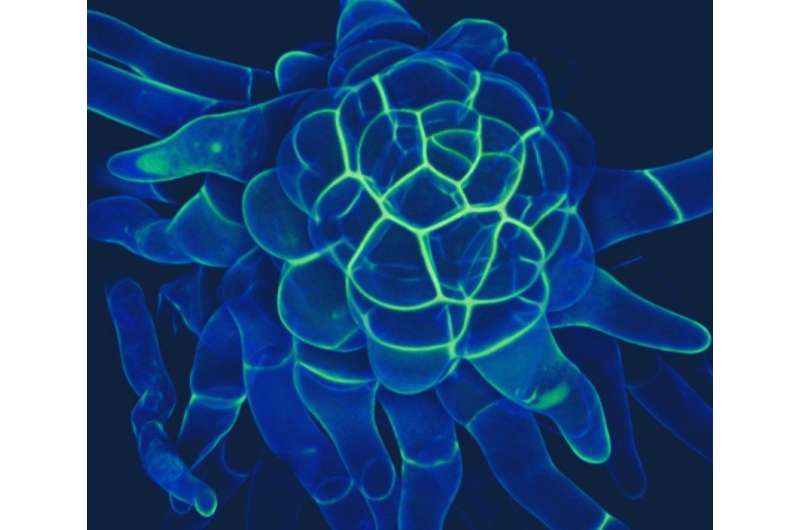Spiralling division planes that lead to 3-D plant forms in the shoot tip of a moss, Physcomitrella. Credit: Dr Jill Harrison, University of Bristol
The Earth is filled with diverse and remarkable plant forms from the tallest redwoods that pierce forest canopies, to the smallest mosses that blanket the ground underfoot.
However, these striking forms came from much simpler origins. The ancestors of land plants were string-like (2-D), aquatic green algae that looked very different from the three-dimensional (3-D), upright stems and leaves of plants we are familiar with today.
Now, researchers at the University of Bristol have revealed exciting insights into how land plants evolved these 3-D forms that were crucial for their advancement onto land.
The research, published today in the journal Current Biology, led by Dr. Jill Harrison from the University's School of Biological Sciences, and collaborators, found that small proteins known as CLAVATA peptides, control the growth and division of cells at the very tips of plants, which generate organs such as the shoots and leaves.
CLAVATA is a peptide and receptor based signalling system. The peptide moves to the receptor to set the cell division planes.
However, when the researchers looked for CLAVATA molecules in the aquatic algae ancestors, they could not find them.
This showed that CLAVATA proteins evolved just as the first plants moved onto land.
Using mosses to exemplify the 2-D to 3-D growth transition, the researchers showed that CLAVATA protein rotate cell divisions at the tips of plant stems enabling growth in multiple directions.
Dr. Harrison, a Royal Society University Research Fellow, said: "The CLAVATA genes were found to be specific to land plants to regulate their unique 3-D growth patterns and so it looks like these genes were instrumental in enabling plants to get going on land.
"After this fundamental change in cell division patterns, plants could now develop many different forms, enabling them to dominate almost every environment on Earth, and so this work reveals a key role for these small proteins in plants' conquest of land."
More information: 'CLAVATA was a genetic novelty for the morphological innovation of 3D growth in land plants' J. Harrison et al. Current Biology (2018).
Journal information: Current Biology
Provided by University of Bristol






















